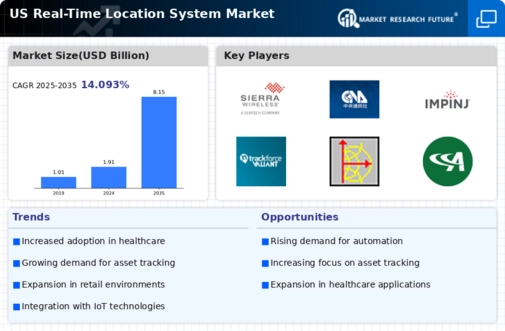The US Real-Time Location System (RTLS) Market is characterized by rapid advancements in technology and heightened demand for location-based services across various industries. As organizations increasingly recognize the value of real-time visibility for asset tracking, personnel safety, and operational efficiency, the competitive landscape has become increasingly dynamic and nuanced. Key players are innovating to enhance their offerings and maintain a competitive edge, leveraging technologies such as RFID, Wi-Fi, and Bluetooth to provide comprehensive RTLS solutions. The significance of real-time location data extends beyond asset management; it plays a crucial role in improving workflow efficiency and overall productivity.
As a result, companies in the RTLS space are constantly refining their strategies to capture market share while addressing the diverse needs of their clients.Sierra Wireless has established a strong foothold in the US Real-Time Location System Market by emphasizing innovative technologies and reliable connectivity solutions. The company is renowned for its advanced IoT platforms, which facilitate seamless data integration and real-time tracking capabilities. These strengths allow Sierra Wireless to cater effectively to various sectors, including healthcare, manufacturing, and logistics, where accurate location data is vital.
Their robust wireless communication solutions combined with specialized RTLS technology enable businesses to enhance operational efficiency, minimize errors, and ensure safety. Furthermore, Sierra Wireless benefits from a solid reputation for quality and service, enabling them to foster long-term partnerships with clients seeking dependable RTLS solutions in an increasingly competitive market.Centrak is a key player in the US Real-Time Location System Market, recognized for its extensive portfolio that includes real-time tracking solutions for healthcare organizations and other sectors requiring precise asset and personnel monitoring.
The company provides critical products and services, including tags, infrastructure, and sophisticated software platforms that facilitate the seamless integration of location data into enterprise management systems. Centraks' strength lies in its focus on addressing specific industry needs, particularly in healthcare, where efficient resource management is paramount. The company has actively pursued strategic partnerships and collaborations, enhancing its capability to deliver comprehensive RTLS solutions tailored to client requirements. Moreover, Centraks' ongoing efforts in research and development have yielded innovative solutions that leverage the latest advancements in location technology.
Their presence in the US market is further solidified by successful mergers and acquisitions that have expanded their product offerings and market reach, ensuring that they remain a formidable competitor in the rapidly evolving RTLS landscape.






















